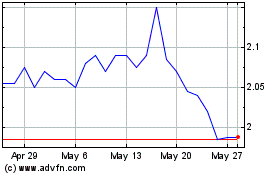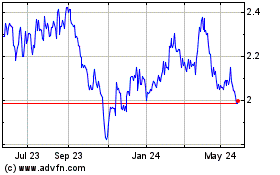By Mike Cherney
Two years ago, Australian shopping-center operator Mirvac Group
launched a new effort to help retain customers amid rising
competition from online retailers: combine a trip to the mall with
a scenic boat ride in iconic Sydney Harbour.
The so-called Shopper Hopper service has ferried 23,000
customers to two Mirvac malls along the coast, part of a continuing
initiative to convince shoppers that a mall visit offers unique
experiences that can't be found in front of a computer.
Mirvac had good reason to beef up its defenses against online
retail competition. In December, the biggest and baddest online
retailer of them all, Amazon.com Inc., launched its full retail
website in Australia and opened its first local warehouse in the
country.
Previously, Australians had to shop on Amazon's U.S. and U.K.
websites for most products, which meant hefty shipping fees and
long delivery times. Although other big online retailers such as
eBay Inc. have been popular in Australia, up until recently the
country's consumers have been mostly hooked on bricks-and-mortar
stores.
Now, the launch of full service by Amazon has sparked concerns
that Australian shopping centers face the same carnage that has
undermined many a retail landlord in countries that got hit early
by the online shopping juggernaut. Indeed, shares of Scentre Group
Ltd., the largest listed retail property company in Australia, have
been trading at about 4 Australian dollars (US$3) recently, down
from about A$5.40 in mid-2016.
But the Shopper Hopper service and other efforts by Australian
retail landlords to make trips to the mall more fun are a sign that
they're not going to be a pushover for Amazon and other online
retail giants. Investors and analysts say mall operators here have
spent the past few years adding amenities and remixing tenants to
keep shoppers interested, which should insulate them from some of
the pain.
"Australian shopping center owners and retailers are watching
closely what the impact of Amazon has been around the world, and
they are acting to cope with that," said John Sears, Australia
research director at Cushman & Wakefield.
Moreover, key structural differences between Australian and U.S.
retail also make it unlikely that Australian malls will struggle as
much as their U.S. counterparts, some say. Online sales in
Australia last year made up 8.8% of all retail, compared with 11.8%
in the U.S., according to market-research firm Euromonitor
International.
At the same time, Australia doesn't suffer from the same retail
space glut as does the U.S., which has more than 2.5 times the
retail space per capita, according to Cushman & Wakefield. Mr.
Sears and others attribute that difference to stricter planning
guidelines in Australia that made it more difficult to build large
malls.
The battle between bricks and clicks in Australian retailing
mirrors the way it is playing out in developed countries throughout
the world. Increasingly, landlords who are holding their own are
those who are giving shoppers a wide range of reasons to make the
trip to the mall.
Australian shopping centers also are in better shape because
they have less space devoted to department stores, which have
proved to be vulnerable to online shopping. APN Funds Management,
which invests in Australian real-estate investment trusts, cites
figures from Citigroup Global Markets that show U.S. shopping
centers devoted 46% of space to department stores, compared with
about 20% in Australia.
Meanwhile, entertainment, restaurant and other nonretail
attractions get 19% of Australian retail space, compared with 14%
in the U.S., according to Citi.
"The retail mix of tenants has changed over the years," said
Grant MacKenzie, a senior portfolio manager at Freehold Investment
Management, another Australian fund manager that invests in
property securities. "You're getting a lot more entertainment, al
fresco dining and the like."
The strategy is paying off: Occupancy rates for major Australian
shopping-center owners have been "consistently high for many
years," says Cushman & Wakefield's Mr. Sears.
Scentre Group, which runs some of Australia's top malls, said
its vacancy rate last year was less than 0.5%. The rate hasn't
changed from 2014, when Scentre split from Westfield Corp.
Amazon's expansion in Australia comes as the company is looking
to beef up its global logistics network and could be positive for
industrial properties. Similar to the U.S. and Europe, more
warehouses will be needed for quick deliveries to urban areas.
Amazon's main Australian fulfillment center is a roughly
260,000-square-foot facility near Melbourne in an industrial park
operated by private-company Pellicano Pty. Goodman Group, the
largest listed industrial property company in Australia, said its
occupancy rate at the end of last year was 98%, up from 96% at the
end of 2014.
Amazon is still likely to present some challenges to traditional
landlords. Guaranteeing same-day delivery to customers in some of
Australia's more remote areas will be difficult. But Amazon could
still be a threat in the big east coast cities like Sydney and
Melbourne, where population density is comparable to large U.S.
cities, Andrew Jones, a credit analyst at National Australia Bank,
wrote in a report last year.
Second-tier shopping centers, which may not be big enough for
nonretail attractions, could also be at risk. There is also a limit
to how many restaurants shopping centers can support, given that at
a certain point new food tenants take away sales from existing
ones.
As e-commerce grows, some mall operators are tailoring their
tenant mix to give people more reasons than shopping to visit. At
Chadstone, a mall near Melbourne that is run by Vicinity Centres
and bills itself as the largest shopping center in the country, a
Legoland Discovery Centre opened last year that includes two indoor
rides and a 4-D cinema. A high-quality hotel is also planned at the
mall.
At Mirvac, head of retail Susan MacDonald highlighted how an
Audi automobile service center has been a strong addition to one of
the company's malls in Sydney. "That drives hundreds of people into
that center," she said.
Write to Mike Cherney at mike.cherney@wsj.com
(END) Dow Jones Newswires
May 01, 2018 09:14 ET (13:14 GMT)
Copyright (c) 2018 Dow Jones & Company, Inc.
Mirvac (ASX:MGR)
Historical Stock Chart
From Feb 2025 to Mar 2025

Mirvac (ASX:MGR)
Historical Stock Chart
From Mar 2024 to Mar 2025
